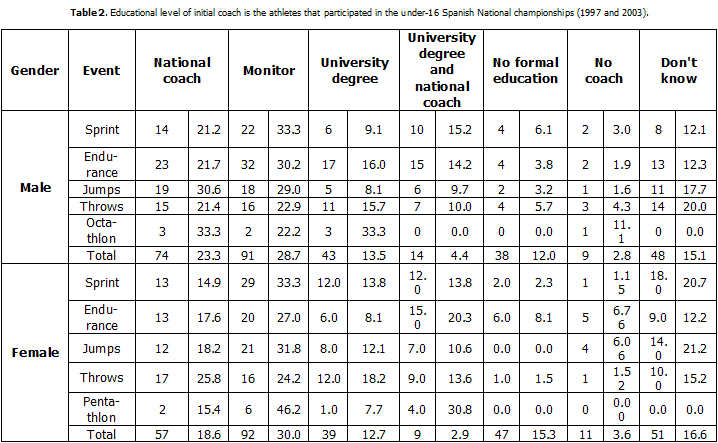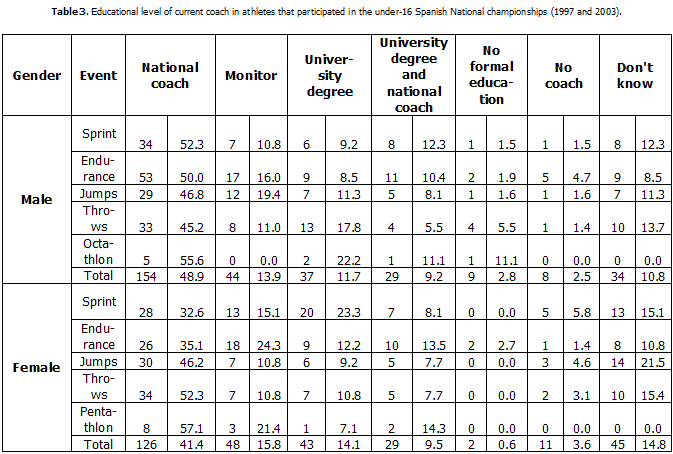
|
|||
|---|---|---|---|
|
|
Age, place of sport initiation, and coacher' education in under-16 Spanish track and field athletes in relation to their events Edad, lugar de inicio, formación de los entrenadores en atletas españoles cadetes en relación a sus pruebas |
|
|
|
Faculty of Health, Physical Activity & Sport, Catholic University of St. Anthony, Murcia. (Spain) |
Dr. José Manuel Palao | Dr. Antonio Calderón jmpalao@pdi.ucam.edu | acluquin@pdi.ucam.edu Dr. José Arturo Abraldes | Dr. Enrique Ortega aabraldes@pdi.ucam.edu | eortega@pdi.ucam.edu |
|
|
|
|
|||
|
|
http://www.efdeportes.com/ Revista Digital - Buenos Aires - Año 12 - N° 117 - Febrero de 2008 |
|
|
1 / 1
Introduction
The characteristic of initiation to sport practice influences the sport life of the athletes (ex. the years of practice influences the degree of development of the different capacities). In track and field, the different athletic events require different capacities and different practice conditions. The experts recommend an age of initiation around 10-12 years. This initiation should be generic, multilateral, and orientated toward formation both athletically and in general (Bompa, 1999; Contreras, De la Torre, & Velázquez, 2001; Delgado, Gutierrez, & Castillo, 1997). Further, the figure of the coach or monitor is determinant in children's initial contact of with sport and in their development as an athlete (Abbott, Button, Pepping, & Collins, 2005). The educational level of the coach or monitor is one of the determining factors in the adhesion of their athletes, athletes´ creation of healthy habits, positive attitudes about the sport, values, etc. (Álamo, Amador, & Pintor, 2002; Cohen, 1998; Jiménez, Rodríguez, & Castillo, 2002; Montiel, 1997; Prata, 1998; Williams, & Wilson, 1998; Saura, 1996). The purpose of this study was to find out the age, place that sport initiation took place, and the characteristics of athletics coaches and monitors during athletes´ formative years in relation to the athlete's different events or types of disciplines.
MethodsThe sample was composed of the 636 athletes (322 males and 314 females) that participated in the Spanish Youth Athletics Championship in the years 1997 and 2003 (average age was 15.13 years). The variables studied were: gender, event (sprint, endurance, jumps, throws, and octathlon-pentathlon), age at initiation, place of initiation, number of coaches that athletes have had, and degrees of the coach with whom they started and the coach at the time of the Championship. The variable dealing with education of the coaches was categorized as: national coach, monitor, university degree, no formal education, both university degree and national coach, had no coach, and don't know. An ad-hoc questionnaire to register the studied variables was used. Descriptive (frequency and percentage) and inferential (Chi-square test) statistical tests were done using SPSS 12.0 software.
ResultsThe age the athletes initiated their sports participation is very similar between events and one year later in males than in females (11.3 years and 10.4 years, respectively). With regard to the place of initiation, the results show that between eight and nine of every 10 athletes started in school or in a sports club. 47% of boys and girls began in school, while 39% of boys and 34% of girls started in clubs. By event, similar values were found in general. A significances differences was found in the reduced number of male athletes that both initiated their athletic experience in school and practiced octathlon (p<0.004).

The average number of coaches both by gender as well as by event is 2±1 coaches. A 2.8-3.6% of the athletes participating in these Championships indicated that they have not had a track & field coach, and 10-16% of athletes did not know the educational level of their coaches.
With regard to education of the initial coach, 28-30% of the coaches had the monitor coaching certificate, and 22-27% had the national coaching certificate with or without a university degree. However, one of every 10 athletes started training under a coach without educational formation (usually former athletes, other athletes, or parents). Statistical significance by event was not found.
In relation to education of the current coaches, almost 60% of the athletes were coached by national coaches. The role of the monitors was reduced to half with respect to the time of sport initiation. Significant differences by events were not found.


Discussion and conclusionsThe age of initiation for the Spanish athlete studied was around 10-11 years. Female athletes started sooner than males to practice track and field. These values are similar to those that experts recommend. Therefore, Spanish athletes have enough time to get an adequate learning and training process. Future studies should be done to find out the type of work done during the formative period.
It was observed that the place of initiation for practicing sport for less than half of the athletes was in school. These values are below those recommended by the experts. These data show the necessity to organize promotional campaigns in schools and reorganize the role of schools for sport initiation in Spain. Few athletes that start in school participate in multi-event disciplines. This result may be because this discipline requires time and more knowledge and/or perspective from the coaches. Therefore, octathlon and pentathlon athletes had the highest percentage of coaches with track and field national degrees and/or university degrees. These results seem to demonstrate that coaches with higher formation have a tendency to orientate their athletes toward multi-events (although this tendency was not significant).
In relation to coach formation, the high percentage of athletes' current coaches and monitors with adequate educational formation is values similar to other results of studies done in formative years (Abbott, Button, Pepping, & Collins, 2005; Álamo, Amador, & Pintor, 2002; Williams & Wilson, 1998), although these studies were done in male, youth sport in schools. However, a high participation of national coaches in the initial stage is observed, an aspect that should be monitored because it may mean that there are insufficient monitors. These results show the need to include information about formative years in the continuing education of national coaches. Future research should further study the coaches with university degrees but without specific track and field certification.
The results only show a part of the reality, as these data came from the athletes that participated in the National Championship and further only included what the athletes knew or remembered about their coaches (10-15% of athletes did not know the educational formation of their coaches). More studies should be done to find out the way in which the starting and formation process is done in the different sports.
References
Abbott, A., Button, C., Pepping, G. J. &, Collins D. (2005). Unnatural Selection: Talent Identification and Development in Sport. Psychological Life Science, 9(1),61-88.
Álamo, J. M., Amador, F., & Pintor, P. (2002). Función social del deporte escolar. El entrenador del deporte escolar. Lecturas: Educación Física y Deportes, 45.
Disponible en http://www.efdeportes.com/efd45/escolar.htmBompa, T. (1999). Total Training for Young Champions. Human Kinetics: Champaign.
Contreras, O., De la Torre, E., y Velázquez, R. (2001). Iniciación deportiva. Madrid: Síntesis.
Delgado M., Gutiérrez, A., & Castillo, M. J. (1997). Entrenamiento físico deportivo y alimentación. Paidotribo. Barcelona.
Jiménez, F. J., Rodríguez, J. M., & Castillo, E. (2002). Necesidades de formación psicopedagógica de los entrenadores deportivos. Revista Ágora Digital, 2, 1-9.
Cohen, R. (1998). Principios fundamentales para una escuela integral de fútbol base. Training fútbol, 25, 30-41.
Prata, C. (1998). Treinador de jovens. Ideas, formaçao, problemas. Treino Desportivo, 10, 15-20.
Montiel, A. (1997). Treinador: técnico o formador. Treino desportivo, 9, 7-11.
Williams, J., & Wilson, S. (1998). Coaching and playing. Indianapolis: Master Press.
Saura, J. (1996). El entrenador en el deporte escolar. Lleida, Spain: Institut d´Estudis Ilerdencs.
 |
|
|---|---|
|
revista
digital · Año 12
· N° 117 | Buenos Aires,
Febrero 2008 |
|